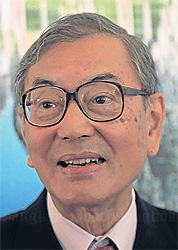'This is pong [eggs]. This is chake [bananas], and charouk [pork], the offerings for the deities," Wipa Putthong used several Khmer words as she demonstrated a folk ritual to her audience.

Thai and Cambodian students on a field trip led by Col Surat Lertlam, front right, and Im Sokrithy, front, second right, part of the Heritage Education Programme aimed at promoting mutual understanding. CHAMLONG BOONSONG
Although Wipa's Khmer accent was far from perfect, the audience, many of who were Cambodian students, loved it. They showered the girl, a Mathayom 4 student at Sa Kaeo-based Tappraya School, and her team with loud applause at the end of the presentation of the final activity of the Asean Youth Research Programme (Thai-Khmer) under the Heritage Education Programme for Students.
The programme, jointly organised by Cambodia's Apsara Authority and the Thailand Research Fund (TRF), together with other conservation agencies, is based on the belief that the constantly strained relations between Thailand and Cambodia can be eased through better mutual understanding of shared cultural ties. And the earlier the understanding is fostered, the better.
Over the past year the programme has trained Thai and Cambodian students - from two schools in Thailand and two in Cambodia - to be young researchers on local cultures. They were Tappraya School in Sa Kaeo province, Sung Noen School in Nakhon Ratchasima, Banteay Chhmar School in Banteay Meanchey province and Kompong Chheuteal School in Kampong Thom.
At the end of the programme, they took turns sharing what they learned during their field research. The Banteay Chhmar team, for example, shared what they had learnt from a series of exploration trips to temple ruins and pre-historic archaeological sites around their village in Banteay Meanchey province. The knowledge-sharing session at Apsara's conference hall was also open to Cambodian students in Siem Reap and neighbouring towns including Si Sophon. Each sent 10 students to the programme.
Wipa said she picked up some Khmer words from locals in her Baan Lalomtim village in Sa Kaeo's Tapraya district which borders Cambodia. "They still use the dialect in their daily life," she said.
The dialect indeed made it easier for Wipa to break the ice with new friends from Cambodia. Language barriers, however, posed no serious problem for the young people with the same archaeological interests.

Former foreign minister Tej Bunnag
The students said the two-day programme made them realise the shared cultural roots of the peoples of the two countries. They have similar folk games, traditional healing practices done through a medium, and rain-making prayers and rituals. Very little differences exist in these shared customs and rituals, they pointed out.
Khuon Khun Neay, deputy director general of Apsara, lauded Cambodian students' undaunted spirit.
"That they have no modern gadgets was no problem for them at all. They simply wrote their reports by hand," he said.
Col Surat Lertlam, head of the Heritage Education Programme on the Thai side, said the programme has effectively groomed a love for conservation among the youngsters of both countries.
The locals also appreciated the youngsters' efforts. "When they encountered artefact smuggling, they told the students who subsequently alerted the authorities," said Col Surat.
The Heritage Education Programme's aim is to foster a better understanding between young people in the two countries currently trapped in historical conflicts, particularly the Preah Vihear temple row.
The Heritage Education Programme is an offshoot of earlier cooperation between Thailand's TRF and Cambodia's Apsara. Eight years ago, they jointly explored the royal route linking the ancient Khmer kingdom to Pimai in the Northeast of Thailand and now they are preparing to extend the study to cover other ancient routes - to Laos and to Vietnam.
Apart from field research, the programme also included a study trip to the Angkor Archaeological Park and to the first ancient bridge that linked the west road of the Khmer kingdom to Sdok Kok Thom on the Thai side.
During the trip, it was not possible to avoid the issue of the "love-hate" relationship between the two kingdoms. During a stop at the western gate of the ruins at the Bayon temple, Im Sokrithy, chief of Cambodia's Department of Communication and co-director of the Living Angkor Road Project who leads the programme on the Cambodian side, told the students in a solemn voice: "It was through this gate that the Siamese army invaded and defeated the old Khmer kingdom."
But he was quick to add: history is just a lesson.
"The past is the past. If we think too much about it, the more pain we feel. The point is how we, the current generation, should live and make it a win-win situation for both sides."
Tej Bunnag, Policy Board member of TRF, said the Heritage Education Programme is a good start to boost understanding between the peoples and help transcend ultra-nationalism.
National boundaries are a recent product of modern society. People on both sides of the borders, however, share a similar culture.
"In the past, there were no national boundaries in this area," said Mr Tej, former foreign minister.
"Nationalism is a reality we cannot deny because everyone loves his and her nation first and foremost.
"Yet, we have to learn how to live with this 'reality' in a way that ensures that it will not hurt the ties we have with our neighbours."